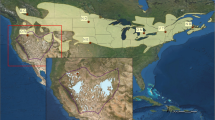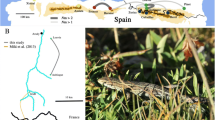Abstract
The Rufous Hummingbird (Selasphorus rufus) population is declining in some areas of North America, but not in others. The reasons for the decline are, as yet, unknown. Understanding the genetic population structure of this species could be useful in understanding its dispersal behaviour and whether particular geographical areas should be treated as separate conservation units. We tested 16 microsatellite markers designed for other hummingbird species for amplification in Rufous Hummingbirds. Using six polymorphic markers, we found that the Rufous Hummingbird population was weakly structured such that birds breeding in central British Columbia could be distinguished from those breeding on Vancouver Island and those in Alberta, each several hundred kilometres away. Whether landscape features such as the Rocky Mountains and Fraser River Valley significantly affect dispersal patterns requires further investigation.
Zusammenfassung
Genetische Variabilität und Struktur bei der Rotrücken-Zimtelfe
Die Rotrücken-Zimtelfe (Selasphorus rufus), eine Kolibriart in Nordamerika, nimmt in manchen Gebieten ab, in anderen jedoch nicht. Die Ursachen des Bestandsrückgangs sind bisher jedoch weitgehend unbekannt. Um entsprechende Schutzstrategien für die einzelnen Populationen gezielt entwickeln zu können, ist ein besseres Verständnis der genetischen Struktur und damit der Wanderbewegungen zwischen den einzelnen Populationen notwendig. Insgesamt wurden in dieser Arbeit 16 Mikrosatellitenmarker anderer Kolibriarten getestet und auf ihre artspezifische Eignung hin überprüft. Sechs polymorphe Marker konnten erfolgreich für die Analysen bei S. rufus etabliert werden. Die Populationen zeigten nur geringe genetische Unterschiede, Individuen aus Vancover Island, British Columbia, und Alberta ließen sich jedoch unterscheiden. Welche Rolle Bergzüge wie die Rocky Mountains oder Täler wie das Fraser River Valley für das Dispersal der Art hat, sollte in zukünftigen Studien genauer analysiert werden.



Similar content being viewed by others
References
Aebischer NJ, Potts GR (1994) Quail Coturnix coturnix. Birdlife International, Cambridge
Alcaide M, Serrano D, Tella JL, Negro JJ (2009) Strong philopatry derived from capture-recapture records does not lead to fine-scale genetic differentiation in lesser kestrels. J Anim Ecol 78:468–475
Avise JC, Walker D (1998) Pleistocene phylogeographic effects on avian populations and the speciation process. Proc R Soc Lond B 265:457–463
Clark RG, Hobson KA, Nichols JD, Bearhop S (2004) Avian dispersal and demography: scaling up to the landscape and beyond. Condor 106:717–719
Corander J, Marttinen P (2006) Bayesian identification of admixture events using multilocus molecular markers. Mol Ecol 15:2833–2843
Corander J, Waldmann P, Marttinen P, Sillanpaa MJ (2004) BAPs 2: enhanced possibilities for the analysis of genetic population structure. Bioinformatics 20:2363–2369
Corander J, Marttinen P, Mantyniemi S (2006) A Bayesian method for identification of stock mixtures from molecular marker data. Fish Bull 104:550–558
Esler D, Iverson SA, Rizzolo DJ (2006) Genetic and demographic criteria for defining population units for conservation: the value of clear messages. Condor 108:480–483
Excoffier L, Smouse P, Quattro J (1992) Analysis of molecular variance inferred from metric distances among DNA haplotypes: applications to human mitochondrial DNA restriction data. Genetics 131:479–491
Falush D, Stephens M, Pritchard JK (2007) Inference of population structure using multilocus genotype data: dominant markers and null alleles. Mol Ecol Notes 7:574–578
Finlay JC (2007) Nine years of banding and recapture of hummingbirds in Southern British Columbia. Br Columbia Birds 15:9–23
Gagneux P, Boesch C, Woodruff DS (1997) Microsatellite scoring errors associated with noninvasive genotyping based on nuclear DNA amplified from shed hair. Mol Ecol 6:861–868
Gerloff U, Schlotterer C, Rassmann K, Rambold I, Hohmann G, Fruth B, Tautz D (1995) Amplification of hypervariable simple sequence repeats (microsatellites) from excremental DNA of wild living bonobos (Pan-paniscus). Mol Ecol 4:515–518
Glenn TC, Schable NA (2005) Isolating microsatellite DNA loci. Methods Enzymol 395:202–222
Guillot G, Estoup A, Mortier F, Cosson JF (2005) A spatial statistical model for landscape genetics. Genetics 170:1261–1280
Guo SW, Thompson EA (1992) Performing the exact test of Hardy–Weinberg proportion for multiple alleles. Biometrics 48:361–372
Healy SD, Calder WA (2006) Rufous hummingbirds (Selasphorus rufus). In: Pool A (ed) The birds of North America online. Cornell Lab of Ornithology, Ithaca
Hubisz MJ, Falush D, Stephens M, Pritchard JK (2009) Inferring weak population structure with the assistance of sample group information. Mol Ecol Res 9(5):1322–1332
Kalinowski ST (2005) Do polymorphic loci require large sample sizes to estimate genetic distances? Heredity 94:33–36
Latch EK, Dharmarajan G, Glaubitz JC, Rhodes OE (2006) Relative performance of Bayesian clustering software for inferring population substructure and individual assignment at low levels of population differentiation. Conserv Genet 7:295–302
Marshall TC, Kruuk LEB, Pemberton JM (1998) Statistical confidence for likelihood-based paternity inference in natural populations. Mol Ecol 7:639–655
Milot E, Gibbs HL, Hobson KA (2000) Phylogeography and genetic structure of northern populations of yellow warbler (Dendroica petechia). Mol Ecol 9(6):667–681
Navidi W, Arnheim N, Waterman MS (1992) A multiple-tubes approach for accurate genotyping of very small DNA samples by using pcr—statistical considerations. Am J Hum Genet 50:347–359
Newton I (2008) The migration ecology of birds. Academic Press, Oxford, UK
Oyler-McCance SJ, Fike JA, Talley-Farnham T, Engelman T, Engelman F (2011) Characterization of ten microsatellite loci in the Broad-tailed Hummingbird (Selasphorus platycercus). Conserv Genet Res 3:351–353
Parker PG, Snow AA, Schug MD, Booton GC, Fuerst PA (1998) What molecules can tell us about populations: choosing and using a molecular marker. Ecology 79:361–382
Pearce JM, Talbot SL (2006) Demography, genetics, and the value of mixed messages. Condor 108:474–479
Pritchard JK, Stephens M, Donnelly P (2000) Inference of population structure using multilocus genotype data. Genetics 155:945–959
Rohwer S, Hobson KA, Rohwer VG (2009) Migratory double breeding in Neotropical migrant birds. Proc Natl Acad Sci 106:19050–19055
Ruegg K (2007) Divergence between subspecies groups of Swainson’s thrush (Catharus ustulatus ustulatus) and C. U. swainsoni. Ornithol Monogr 63:67–77
Sauer JR, Hines JE, Fallon J (2008) The North American breeding bird survey, results and analysis 1966–2007. Version 5.15.2008 USGS Patuxent Wildlife Research Center, Laurel, MD. http://www.mbr-pwrc.usgs.gov/bbs/bbs.html
Schneider S, Roessli D, Excoffier L (2000) Arlequin v.2.000: a software for population genetics analysis. Genetics and Biometry Laboratory, University of Geneva, Switzerland
Segelbacher G (2002) Noninvasive genetic analysis in birds: testing reliability of feather samples. Mol Ecol Notes 2:367–369
Selkoe KA, Toonen RJ (2006) Microsatellites for ecologist: a practical guide to using and evaluating microsatellite markers. Ecol Lett 9(5):615–629
Taberlet P, Griffin S, Goossens B, Questiau S, Manceau V, Escaravage N, Waits LP, Bouvet J (1996) Reliable genotyping of samples with very low DNA quantities using PCR. Nucleic Acids Res 24:3189–3194
Walters JR (2000) Dispersal behavior: an ornithological frontier. Condor 102:479–481
Weir BS, Cockerham CC (1984) Estimating F-statistics for the analysis of population structure. Evolution 38:1358–1370
Williamson SL (2001) Hummingbirds of North America. Houghton Mifflin, Boston
Acknowledgments
Financial support was provided by NERC and the Natural Sciences and Engineering Research Council of Canada. We thank Cam Finlay and members of the British Columbia Hummingbird banding network for collecting samples, Jonathan Moran for sharing samples with us, Judith St John and Sara Oyler-McCance for the use of their primers and Jaime Garcia-Moreno for his support and for providing the samples of Lampornis amethystinus that G.S. used to developed the six loci for that species which we have subsequently tested in Selasphorus rufus.
Author information
Authors and Affiliations
Corresponding author
Additional information
Communicated by M. Wink.
Rights and permissions
About this article
Cite this article
Bailey, I.E., Segelbacher, G., Healy, S.D. et al. Microsatellite variation in Rufous Hummingbirds (Selasphorus rufus) and evidence for a weakly structured population. J Ornithol 154, 1029–1037 (2013). https://doi.org/10.1007/s10336-013-0971-2
Received:
Revised:
Accepted:
Published:
Issue Date:
DOI: https://doi.org/10.1007/s10336-013-0971-2




